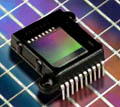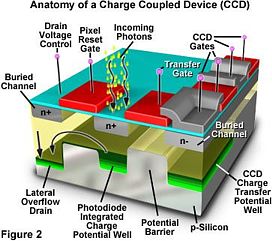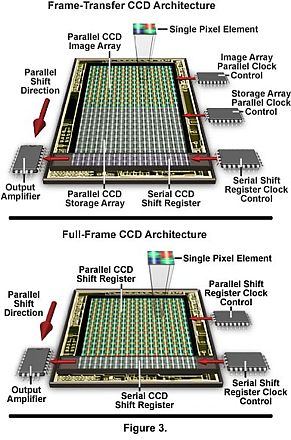Fun With Photos #3
Noise Reduction - Introduction.
Why we get noise in digital camera images.
When using a digital camera, noise is the visible effect of electronic errors and interference.
The quality of the CCD/CMOS picture sensor ( Fig 1) and the ability of the digital signal processing systems inside a digital camera to cope with and/or remove this interference has a direct baring on the amount of noise that results.
Image Sensors
Image sensors are electronic devices with inherent uncertainties, inefficiencies, inaccuracies and mis-charges--all of which can result in unwanted artifacts or noise (Fig 2).
A typical consumer-level digital camera CCD uses Interline Frame Transfer technology. Here the CCD itself can control (start / stop) when it measures light falling on it by shifting values out of the photodiodes (sensor elements) into "shift registers" then pushing all of that data out as a final image. This known as an electronic shutter and can be used to produce a video feed output (a requirement for a live preview LCD feed).
Because of the extra electronics required around each pixel, the "fill factor" (size of the photodiode) tends to be quite small (about 30% of the pixel area). To get around this manufacturers place an array of tiny lenses over the CCD to capture more light and focus it onto the smaller photodiode area which then gives them an better effective fill factor of about 70%.
Such factors increase manufacturing complexity and thus the possibility of assembly errors and therefore noise levels.
CCD's used in professional cameras tend to be Full Frame Transfer, they don't have a shift register, this means that a mechanical shutter is absolutely required to control the start / stop measurement of light. The shutter is opened and then closed again (say 1/60s later), the whole CCD shifts data off itself into the serial register where it's processed as the "RAW" image.
Full Frame CCD's are simpler, don't have shift registers and the associated electronics around each photodiode, and don’t require an array of tiny lenses, they have a much better Fill Factor of around 70%. Full frame CCDs generally produce much less noise and can be operated at much higher ISO levels. A disadvantage however with Full Frame CCDs is that you can't get a video feed from them, meaning no LCD preview is available.
The array of pixels on a sensor is often non-uniform in their reaction to light, creating areas of less or greater sensitivity on the sensor. This, too, can be considered a type of noise. While there are numerous noise sources on a sensor, the most significant noise, especially in relationship to dynamic range, is dark current--unwanted signal that is measured by reading the image that would be captured in the dark when there is no illumination.
ISO Sensitivity & Temperature
The amount of visible noise in a digital image is also affected by temperature and ISO sensitivity. Dark current noise increases at higher operating temperatures with the dark noise level doubling for every 6 to 8 degrees Celsius increase in temperature.
The primary sources of dark current noise are impurities in the initial silicon wafer or damage to the silicon crystal lattice. The latter type of flaw results in ‘stuck pixels’ which can often be observed as ‘stuck pixels’ at the same position relative to the edges of the image in sequential shots. Stuck pixel noise becomes more evident when using long exposure times and is usually distributed sparsely within the image as very high contrast (full black or full white) pixels. Higher quality, more expensive silicon will produce less noise, but will also increase the cost of the camera. Some processing technologies used in the sensor fabrication, such as the energy introduced by ion implantations, can also increase noise potential.
Sensor Size & Quality
Sensor size relative to the number of pixels can also affect noise. If you pack more pixels into the same size sensor the pixels get smaller and there is a greater probability of electronic interference which creates noise, thereby reducing dynamic range (Fig 3). This is one reason that larger (but more expensive) sensors are preferred for higher quality digital cameras. The sensor size:number of pixels ratio will affect the camera’s ISO (film speed) capabilities and so lower quality (smaller size) sensors will usually result in more noise at higher ISO settings than more expensive (larger) sensors. Designers of digital cameras have striven to reduce noise, producing cleaner images, and newer digital cameras can now use much higher ISO settings without creating too much noise.
Sensor quality affects the amount of optical and electrical crosstalk between detector elements in the sensor.
Optical Crosstalk
Optical Crosstalk results when a photon intersects at an angle with a filter element in the CFA and enters the adjacent pixel's photodetector (photodiode) and not the photodetector under the filter element. This can contaminate the adjacent pixel's charge packet (Fig 4).

Fig 4. Optical Crosstalk in CCDs
Electrical Crosstalk
In electrical crosstalk, photons passing through the red filter travel further into the silicon before generating electrons. This leads to a non-uniform response to the different colours, a loss of charge into the substrate and electrons wandering into the wrong pixel well. (Fig 5).

Fig 5. Electrical Crosstalk in CCDs
Other Factors: Colour Channels, JPEG Artifacts, Colour Variability
Noise is sometimes more apparent in certain colour channels than the others because the typical digital camera CCD or CMOS sensor is more sensitive to certain primary colours than others. For instance, some sensors are less sensitive to blue light and so the blue channel is amplified more than the others to compensate, resulting in an amplification of the interference along with the image.
Noise is also often generated and amplified by JPEG compression algorithms, commonly used in digital cameras. JPEG compression algorithms can sometimes also introduce colour shifts, especially when the algorithm acts upon a noisy region of the image.
Although noise can be evident throughout the entire image, it is often more prevalent (or more easily seen) in shadow and highlight regions, and in areas of low colour variability (walls etc).
Part 2 of this tutorial provides some sample images taken at 50, 100, 200 and 400 ISO settings with my consumer-level Canon S40 digital camera. A small section of the image is magnified at 200% of the original to show the increasing level of noise at increasing ISO settings.
Please continue with Part 2 of this tutorial, Noise Reduction Techniques using Corel Photo-Paint.
Goto PART 2: Noise Reduction Techniques ->
April, 2005.



